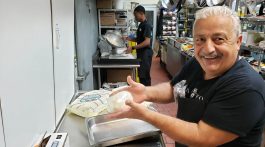Feta, Parmesan, Brie, Roquefort, Fontina, Gorgonzola – they’re all cheeses piled high in the supermarkets across the country. But what do those names mean? They’re actually names of places in Europe and the cheeses made there. In the US, they are used to name cheese regardless of where it is made and what it tastes like. United States cheese producers have co-opted the old world names, and the Europeans want them back.
The European Union has launched a campaign to prevent their cheese classification terminology from being used by others. In trade talks with the US, the EU is asking that the US cheese industry stop using cheese names from their member nations. To show they mean business, agreements have been made with South Korea and Canada to ban Feta that is not from Greece and Gorgonzola, Parmesan and Asiago not made in Italy. Even England, not a member of the EU, is taking steps to reclaim the Cheddar name.
Most cheeses made in America are based on a European style, although some have drifted pretty far from the mark. The only uniquely American mass market cheeses may well be American cheese (which may not be cheese at all) and its cousin Velveeta. These are, however, examples of the types of names or brands that the EU would like to see adopted on a wider scale – proprietary names, not the Euro names. Artisanal cheese makers, working on a smaller scale, have been doing this right along – Maytag Blue instead of Roquefort, and Cato Corner Farm Dairyere instead of Gruyère or Comté. But for the big brands, it’s a nightmare.
Imagine a world without a huge selection of domestic Cheddar in its many style and flavor variations or no Swiss cheese unless it was from Switzerland. What would the cheeses made in the US be called?
The wine industry confronted the same issue – raised by the French – in its early days. Remember Hearty Burgundy, Chablis, and Sauternes in big jugs? As the California wine industry moved upscale, it was blocked from using French names. Chablis was to mean a crisp, stony, dry white wine made with Chardonnay grapes from the town of Chablis in France, not a blended mix of fruity, sweet wines from a tank farm in Modesto. The French prevailed and California wineries used the grape variety and later the region to designate their wines – Napa Valley Cabernet, Sonoma Coast Pinot Noir and the like. Recognizing that the French were right, there is now a complex system of laws in California to control the use of place names and protect the consumer.
For the battle over cheese names, I think the cow (or goat or sheep) has left the barn. According to the Wisconsin Cheese Makers Association, 11 billion pounds of cheese is produced in the US annually. That’s a lot of milk, manufacturing and consumers to deal with. On a practical level, I just don’t see how the naming can be changed. The EU is right. Their cheese names have been borrowed (or worse) resulting in the dilution of their reputation and brands. But, unlike the wine industry, the protest is too late. They missed their chance and let the names become ingrained in common use, although a marketing campaign pointing out the unique flavors and qualities of EU cheeses, shaming the US cheese industry into re-branding, might be effective.
Across the US, artisanal cheese makers are producing great cheese based on European styles and recipes. But they’re not using the old world names. They might say that their cheese is in the style of or modeled after a Euro cheese, but they know that their cheese will be unique and market it as such. Local milk; the individual cheese-making environment of temperature and humidity; natural mold and bacteria; as well the talent of the cheese maker will create distinctive flavors.
American artisanal cheese makers often make several widely diverse styles of cheese at the same location. They are not restricted to just one type of cheese made according to the official method, like the Europeans. The EU system of protection for the traditional cheeses also limits production to just those cheeses. Without that kind of restriction, American cheese makers are free to experiment and evolve. Like the wine industry, they may find that certain locations are best for a particular cheese, but that knowledge is probably a couple generations down the road.
I encourage you to try some of the authentic cheeses that the EU is trying to protect. You’ll find them delicious and often a world away from their American imitators. Go to a good cheese shop to find the best examples. You may even think they’re worthy of protection after you’ve had a taste!












No Comment